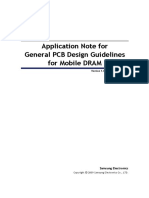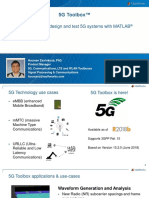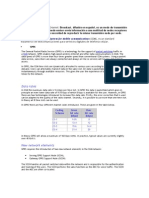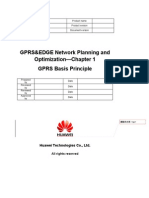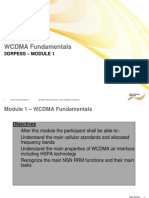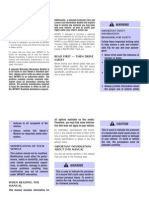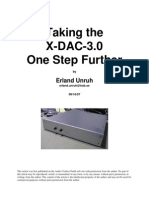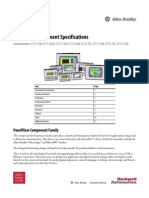6 zt1231302 PDF
6 zt1231302 PDF
Uploaded by
jedossousCopyright:
Available Formats
6 zt1231302 PDF
6 zt1231302 PDF
Uploaded by
jedossousOriginal Title
Copyright
Available Formats
Share this document
Did you find this document useful?
Is this content inappropriate?
Copyright:
Available Formats
6 zt1231302 PDF
6 zt1231302 PDF
Uploaded by
jedossousCopyright:
Available Formats
Study case, GPRS
Chapter 6
This chapter is designed to provide the student with an
understanding of how to make GPRS traffic planning with
TEMS CellPlanner.
OBJECTIVES:
Upon completion of this chapter, the student will be able to:
• Define GPRS coding schemes
• Create GPRS best server arrays
• Define GPRS terminal types
• Make traffic analysis for both voice and data traffic.
GSM Cell Planning Workshop
t io
e n na
I nt
lly
Bl n
a
k
EN/LZT 123 1302 R3A
Study case GPRS
Study case, GPRS
Table of Contents
Topic Page
GENERAL .................................................................................................................... 49
TRAFFIC DATA ........................................................................................................... 50
TRAFFIC DISTRIBUTION ........................................................................................... 50
CODING SCHEMES.................................................................................................... 51
OCCUPANCY FUNCTION .......................................................................................... 51
TERMINAL TYPES ...................................................................................................... 52
WWW DIMENSIONING GRAPHS............................................................................... 52
PRESENTATION OF GPRS STUDY CASE................................................................ 54
EN/LZT 123 1302 R3A –i–
GSM Cell Planning Workshop
t io
e n na
lly
t
In
Bl n
a
k
– ii – EN/LZT 123 1302 R3A
Study Case GPRS
GENERAL
The task is to create a new project called “GPRS” and
implement GPRS in the sites. You will first analyze the offered
throughput (kbps) with the existing TRX configuration, and then
you are to dimension the network for a throughput of 20 kbps.
You are to export 12 sites from the P2 area in your original
project and import these sites to the new project “GPRS”.
Before you import the sites in your “GPRS” project the following
have to be defined/imported: Propagation model, antennas.
You have to spread speech traffic in the area, perform
frequency planning and allocate frequencies before starting the
GPRS planning.
Main steps in the GPRS definition:
• You are to allocate GPRS service to all imported sites in the
phase 2 area (do not include the urban sites from the study
case phase 3). At this stage the operator is planning to
implement only “On-demands Packet Data Channels”. This
means that a certain (basic) GPRS capacity will be
available in the existing network, without adding any extra
transceivers.
• You have to define the relevant coding schemes to be used
in this phase. Use default values.
• You should also define the TS occupancy vs. number of
available timeslots table. Use default values.
• The next step is to define a terminal type for the GPRS
device that is to be used in the network. If you have multiple
devices with different capacity, you have to define one
Terminal type for each device.
• When all definitions are made, you can spread the speech
and GPRS traffic with the Raster Wizard and finally analyze
the traffic. You have to use the graph “Median throughput
versus offered WWWload” to determine the amount of
TRXs in the cells. The results are only valid for cases
where the average number of TS for GPRS is around 4
or larger.
EN/LZT 123 1302 R3A – 49 –
GSM Cell Planning Workshop
• The cells in your project then have to be updated with the
necessary number of TRXs to handle the GPRS traffic in
the area. Update the required number of TRXs in your site
database, perform new frequency planning and then apply
the plan. Create interference array and necessary GPRS
arrays.
TRAFFIC DATA
The same subscriber data and subscriber behavior as previous
phase can be assumed. It is assumed that GPRS busy hour
overlaps speech busy hour.
TRAFFIC DISTRIBUTION
The speech traffic in the P2 area is stipulated to 300 Erlang.
The operator is planning for a number of 400 active GPRS
terminals in the phase 2 area. It is further expected that each
user will utilize GPRS three times during busy hour and
download 4000 Kb per session.
The operator is planning to offer a median throughput of 20
kbps in the phase 2 area.
– 50 – EN/LZT 123 1302 R3A
Study Case GPRS
CODING SCHEMES
At this stage only Coding Scheme 1 and 2 will be available for
the phase 2 sites.
Throughput per channel
CS-2
10
CS-1
0
0 5 10 15 20 25 30
C/I [dB]
Fig. 1
In TCP define the “average data throughput per TS versus
average C/I” for CS-1 and CS-2 using data in the figure.
OCCUPANCY FUNCTION
In TCP define the “default set of timeslot occupancy vs number
of available timeslots” for timeslots 1 to 48.
EN/LZT 123 1302 R3A – 51 –
GSM Cell Planning Workshop
TERMINAL TYPES
Speech
Create a new Terminal Type called Terminaltype_1 for speech
with the following clutter weight data:
Urban: 10
Village: 7
Suburban: 5
Half open: 3
Pine Forest:1
Data
It is expected to be only GPRS 4-slot mobiles in the phase 2 area.
Create a new Terminal Types called GPRS_4 for packet switched data
with the following clutter weight data:
Urban 10
Village 7
Suburban 6
Half open 3
WWW DIMENSIONING GRAPHS
This section includes simulation results to be used in the
dimensioning. The graph shows http object throughput versus
offered WWW load (kbps/pdch).
The results are only valid for cases where the average number
of PDCHs is around 4 or larger
Figure 2 shows the downlink http object throughput for 4-slot
mobiles using CS2.
– 52 – EN/LZT 123 1302 R3A
Study Case GPRS
The throughput is measured as the median throughput, which
means that 50% of the http objects have a throughput larger
than this value (or that 50% of http objects have a throughput
smaller than this value). Figure 2 can be used for both on-
demand and dedicated PDCHs since the use of on-demand or
dedicated PDCHs does not affect the median throughput.
Fig. 2
EN/LZT 123 1302 R3A – 53 –
GSM Cell Planning Workshop
PRESENTATION OF GPRS STUDY CASE
The presentation should contain the following:
• A verbal description of the proposal.
• GPRS Indoor Coverage (%)
• % of cells offering a median throughput of 20 kbps (before
adding any TRXs)
• C/I worst interference array >12dB (%) before GPRS
• C/I worst interference array >12dB (%) after adding TRXs
for GPRS
• Additional no. of TRXs after implementing GPRS
– 54 – EN/LZT 123 1302 R3A
You might also like
- Node Group Synch - WorkshopDocument38 pagesNode Group Synch - WorkshopEmmanuel Adu-Kissiedu100% (2)
- Indoor Radio Planning: A Practical Guide for 2G, 3G and 4GFrom EverandIndoor Radio Planning: A Practical Guide for 2G, 3G and 4GRating: 5 out of 5 stars5/5 (1)
- Bill Format Computer Repair ServiceDocument2 pagesBill Format Computer Repair Servicejedossous100% (1)
- Histoire D Haiti Tome V Thomas MadiouDocument3 pagesHistoire D Haiti Tome V Thomas MadioujedossousNo ratings yet
- Plumbing Learning ModuleDocument131 pagesPlumbing Learning ModuleCharlotte's Web86% (14)
- BS Iso 00668-2013 + A2-2016 PDFDocument26 pagesBS Iso 00668-2013 + A2-2016 PDFchertan0% (1)
- GPRS&EDGE Network Planning and Optimization-Chapter 5 Network Planning-20040527-A-1.0Document48 pagesGPRS&EDGE Network Planning and Optimization-Chapter 5 Network Planning-20040527-A-1.0AmrAhmedAbdelFattahNo ratings yet
- GPRSDocument44 pagesGPRSsnehaghodake2110No ratings yet
- GPRS Dimensioning and Performance WorkshopDocument77 pagesGPRS Dimensioning and Performance WorkshopBassem AbouamerNo ratings yet
- GBC 003 E1 0 GPRS Introduction-35Document35 pagesGBC 003 E1 0 GPRS Introduction-35BouabdallahNo ratings yet
- 5G TLW FinalDocument49 pages5G TLW FinalSatyavaraprasad Balla100% (2)
- GBC 003 E0 0 GPRS Introduction-35Document35 pagesGBC 003 E0 0 GPRS Introduction-35hilwana abdulazizNo ratings yet
- Mobile DRAM App Note For PCB Design Guide Rev0-1Document17 pagesMobile DRAM App Note For PCB Design Guide Rev0-1Zoltán BaranyaiNo ratings yet
- Gprs Edge Kpi 30 12 09Document12 pagesGprs Edge Kpi 30 12 09Jamil ArifNo ratings yet
- Toc Gprs Sig CoreDocument17 pagesToc Gprs Sig CoreAbhinav TripathiNo ratings yet
- 3g Interview Qs Latest Ver1Document35 pages3g Interview Qs Latest Ver1NearNo ratings yet
- Inter-BSC Hard Handover in GERAN For The PS Domain R2000: 2.1 Handovers and Cell ReselectionsDocument8 pagesInter-BSC Hard Handover in GERAN For The PS Domain R2000: 2.1 Handovers and Cell ReselectionsNguyenDucTaiNo ratings yet
- Ericsson - Cell PlanningDocument5 pagesEricsson - Cell PlanningBassem AbouamerNo ratings yet
- GPRS Radio Dim CDocument36 pagesGPRS Radio Dim CMokbelNo ratings yet
- 3GPP LTE Design Library: August 2007Document338 pages3GPP LTE Design Library: August 2007Bossoni AdamNo ratings yet
- 5G Toolbox Model, Simulate, DesignDocument21 pages5G Toolbox Model, Simulate, Designarekpanjen0% (1)
- 3GEVOLDocument33 pages3GEVOLNavaneeth KrishnanNo ratings yet
- General Packet Radio Service (GPRS) : Petteri Lappalainen 23.11.1998 IP Tech School Seminar PresentationDocument57 pagesGeneral Packet Radio Service (GPRS) : Petteri Lappalainen 23.11.1998 IP Tech School Seminar PresentationAziz Ur RehmanNo ratings yet
- GO - BT1004 - E01 - 0 GPRS and EDGE Introduction-41Document38 pagesGO - BT1004 - E01 - 0 GPRS and EDGE Introduction-41Sudheera IndrajithNo ratings yet
- Co-Operation With GSM: 1 © NOKIA CTXX 4284/1.0en - PPT/ 29.6.2000 / Timo VakkalaDocument9 pagesCo-Operation With GSM: 1 © NOKIA CTXX 4284/1.0en - PPT/ 29.6.2000 / Timo VakkalaAshu KrNo ratings yet
- GB - BT1003 - E01 - 0 GPRS and EDGE Basics 54Document51 pagesGB - BT1003 - E01 - 0 GPRS and EDGE Basics 54noumizredhaNo ratings yet
- Glosario de TCSDocument4 pagesGlosario de TCSMatias WolfNo ratings yet
- 2G To 3G ISHODocument11 pages2G To 3G ISHOnathaniel1983No ratings yet
- Lte Dimensioning 4 PDF FreeDocument213 pagesLte Dimensioning 4 PDF FreeTarek AhmedNo ratings yet
- LZT1235374 06 PDFDocument8 pagesLZT1235374 06 PDFmohNo ratings yet
- NSW GSM GPRS EdgeDocument72 pagesNSW GSM GPRS EdgeNILESH WANKHEDENo ratings yet
- 5G Questions Nabawy V1Document35 pages5G Questions Nabawy V1أبوعمر الفاروق عبدالرحمنNo ratings yet
- Enhanced Data-Rates For Global Evolution (EDGE) : An OverviewDocument72 pagesEnhanced Data-Rates For Global Evolution (EDGE) : An OverviewPrashant SrivastavaNo ratings yet
- Transmission Network Planning and DesignDocument37 pagesTransmission Network Planning and Designrajeshtripathi2004100% (1)
- DMVPN 3 ScalabilityDocument16 pagesDMVPN 3 ScalabilitypclegrNo ratings yet
- GPRS Radio Network PlanningDocument27 pagesGPRS Radio Network PlanningSudheera IndrajithNo ratings yet
- GPRS&EDGE Network Planning and Optimization-Chapter1 GPRS Basis Principle 20040424-A-1.0Document56 pagesGPRS&EDGE Network Planning and Optimization-Chapter1 GPRS Basis Principle 20040424-A-1.0andr2008No ratings yet
- WB1 1 Data Fundamentals RANDocument71 pagesWB1 1 Data Fundamentals RANankur_infoNo ratings yet
- GSM Wireless Sniffer Using Software Defined Radio: January 2017Document5 pagesGSM Wireless Sniffer Using Software Defined Radio: January 2017X Patrick DarksecNo ratings yet
- PCU Architecture & Technical PresentationDocument23 pagesPCU Architecture & Technical PresentationMohamedSalahNo ratings yet
- Flexi MultiRadio Preparation ExerciseDocument15 pagesFlexi MultiRadio Preparation Exerciseअतुल शर्मा100% (1)
- 5G NR PhyDocument13 pages5G NR PhyBrian HabibNo ratings yet
- SDR 1569282987Document6 pagesSDR 1569282987Ammar Ahmed SiddiquiNo ratings yet
- A Cost-Effective Way To Test Bluetooth® Smart DevicesDocument7 pagesA Cost-Effective Way To Test Bluetooth® Smart Devicesnguyenxuankhanh206No ratings yet
- Gprs Protocol Stack wp1pdfDocument18 pagesGprs Protocol Stack wp1pdfSergey BorisovNo ratings yet
- WCDMA FundamentalsDocument68 pagesWCDMA FundamentalsYoussef YK100% (1)
- GRPS NW PlanningDocument40 pagesGRPS NW PlanningPrashant LabhNo ratings yet
- ND - GSM - Design Paper - Overview of GPRS-EDGE Radio Network Design Process in B10 - Ed1Document6 pagesND - GSM - Design Paper - Overview of GPRS-EDGE Radio Network Design Process in B10 - Ed1Waqas AhmedNo ratings yet
- Iskraemeco - Data Sheet P2LPC-Koncentrator AngDocument4 pagesIskraemeco - Data Sheet P2LPC-Koncentrator AngSuttisak SuriyachanhomNo ratings yet
- Broadband On Trains Generic DescriptionDocument19 pagesBroadband On Trains Generic Descriptionnayamaya63No ratings yet
- Introduction Into Mobile Core Network: Webex Sunday Session 24 March 2013Document35 pagesIntroduction Into Mobile Core Network: Webex Sunday Session 24 March 2013Abdul RehmanNo ratings yet
- Deployment of Precision Time Protocol For Synchronization of GSM and UMTS BasestationsDocument17 pagesDeployment of Precision Time Protocol For Synchronization of GSM and UMTS Basestationsfeku fekuNo ratings yet
- Release 17 - Feature Summary PDFDocument17 pagesRelease 17 - Feature Summary PDFmohd nazir shakeelNo ratings yet
- Hsdpa v1 Cu English JSMCCDocument0 pagesHsdpa v1 Cu English JSMCCginnboonyauNo ratings yet
- GPRS & EDGEDocument37 pagesGPRS & EDGEEr AyushNo ratings yet
- Wind Band Radar Signal Using RF2051Document8 pagesWind Band Radar Signal Using RF2051Khushal KharadeNo ratings yet
- 5G New Radio: PREPARED BY:-Kripal TripathiDocument35 pages5G New Radio: PREPARED BY:-Kripal Tripathirahul mathurNo ratings yet
- LTE Local Traffic Offlloading (SDR LR23)Document28 pagesLTE Local Traffic Offlloading (SDR LR23)paulo.ferreira.flcNo ratings yet
- High-Performance D/A-Converters: Application to Digital TransceiversFrom EverandHigh-Performance D/A-Converters: Application to Digital TransceiversNo ratings yet
- CISCO PACKET TRACER LABS: Best practice of configuring or troubleshooting NetworkFrom EverandCISCO PACKET TRACER LABS: Best practice of configuring or troubleshooting NetworkNo ratings yet
- Release Notes: Analyzer Update October 2020Document15 pagesRelease Notes: Analyzer Update October 2020jedossousNo ratings yet
- Release Notes: Analyzer Update September 2020Document30 pagesRelease Notes: Analyzer Update September 2020jedossousNo ratings yet
- Release Notes: Analyzer Update December 2020Document15 pagesRelease Notes: Analyzer Update December 2020jedossousNo ratings yet
- Release Notes: Analyzer Update May 2020Document21 pagesRelease Notes: Analyzer Update May 2020jedossousNo ratings yet
- Release Notes: Analyzer Update July 2020Document19 pagesRelease Notes: Analyzer Update July 2020jedossousNo ratings yet
- Release Notes: Analyzer Update April 2020Document25 pagesRelease Notes: Analyzer Update April 2020jedossousNo ratings yet
- Release Notes: Analyzer Update March 2020Document14 pagesRelease Notes: Analyzer Update March 2020jedossousNo ratings yet
- Actix Spotlight Desktop User GuideDocument263 pagesActix Spotlight Desktop User GuidejedossousNo ratings yet
- Actix Software Installation GuideDocument30 pagesActix Software Installation GuidejedossousNo ratings yet
- Actix Analyzer Getting Started GuideDocument72 pagesActix Analyzer Getting Started GuidejedossousNo ratings yet
- Actix Diagnostic LogDocument4 pagesActix Diagnostic LogjedossousNo ratings yet
- PWM Solar Charge Contrller: RTC SeriesDocument1 pagePWM Solar Charge Contrller: RTC SeriesjedossousNo ratings yet
- Attach Data Server Connection: LTE ReportDocument3 pagesAttach Data Server Connection: LTE ReportjedossousNo ratings yet
- Traffic Report - Query - Result - 20200217143955468Document60 pagesTraffic Report - Query - Result - 20200217143955468jedossousNo ratings yet
- LogDocument1 pageLogjedossousNo ratings yet
- Bill Format Computer Repair ServiceDocument2 pagesBill Format Computer Repair ServicejedossousNo ratings yet
- Cop India JapanDocument11 pagesCop India JapanJyothsna AnnepuNo ratings yet
- City of Tucson/Pima County Outdoor Lighting CodeDocument17 pagesCity of Tucson/Pima County Outdoor Lighting CodeKOLD News 13No ratings yet
- APC Inrow ManualDocument76 pagesAPC Inrow ManualomarpatNo ratings yet
- 01 ISP Network DesignDocument110 pages01 ISP Network DesignTriSetiawan100% (2)
- LVDT - Spindle Lathe PHDocument7 pagesLVDT - Spindle Lathe PHapi-3756260No ratings yet
- 38 TMSS 03 R0Document0 pages38 TMSS 03 R0renjithas2005No ratings yet
- Altivar 312 Solar ATV312HU11M2412Document3 pagesAltivar 312 Solar ATV312HU11M2412lrc24332725No ratings yet
- Altistart 48 - ATS48D75QDocument5 pagesAltistart 48 - ATS48D75QGoran MladenovicNo ratings yet
- Fire File 25": Certified Fire-Resistant Filing Cabinet of Your Important DocumentsDocument2 pagesFire File 25": Certified Fire-Resistant Filing Cabinet of Your Important DocumentsphuonghdNo ratings yet
- Dole-Form-And-Waiver RamDocument2 pagesDole-Form-And-Waiver RamRamdolph Bundoc100% (2)
- Manual Implem Note 1982417 CONTRATOS SEPEDocument24 pagesManual Implem Note 1982417 CONTRATOS SEPEfrubenvegaNo ratings yet
- NIM RestoreDocument3 pagesNIM RestoreImran RentiaNo ratings yet
- Energy Efficiency Avenues in Indian Industries: Presented by - R.K. PaulDocument44 pagesEnergy Efficiency Avenues in Indian Industries: Presented by - R.K. PaulSatish SaxenaNo ratings yet
- Automata Fix QuestionsDocument12 pagesAutomata Fix Questionsarshdeep singh67% (3)
- LogDocument4,391 pagesLogAndria SutrisnoNo ratings yet
- 1999 Infiniti I30 Owner's ManualDocument281 pages1999 Infiniti I30 Owner's ManualFrankie E. Woo100% (2)
- Answer Key Jee (Advanced) 2018 Paper 1: Q. No. Part I - Physics Part Ii - Chemistry Part Iii - MathematicsDocument1 pageAnswer Key Jee (Advanced) 2018 Paper 1: Q. No. Part I - Physics Part Ii - Chemistry Part Iii - MathematicsYou KumarNo ratings yet
- Swift MaterialDocument1,078 pagesSwift MaterialAbiodun SokanNo ratings yet
- AS 4100 1998 - Steel Structures - 4Document1 pageAS 4100 1998 - Steel Structures - 4benthebassNo ratings yet
- Parker Kill SheetDocument3 pagesParker Kill SheetscrbdgharaviNo ratings yet
- Documents: IT4203: IT Project ManagementDocument8 pagesDocuments: IT4203: IT Project ManagementsathyatrueNo ratings yet
- Lab 10Document10 pagesLab 10Travis Jon Wheelwright83% (6)
- CCNA 2 Routing and Switching Essentials Final Exam AnswersDocument20 pagesCCNA 2 Routing and Switching Essentials Final Exam AnswersFredyMeloNo ratings yet
- CDocument139 pagesCsatya20000No ratings yet
- E. UnruhThe Second X-DacDocument9 pagesE. UnruhThe Second X-DacThorsten LoeschNo ratings yet
- Groen (2) SSB-10GF SteamerDocument2 pagesGroen (2) SSB-10GF Steamerwsfc-ebayNo ratings yet
- Electronic Level Switch: Description: Technical DataDocument4 pagesElectronic Level Switch: Description: Technical DataCarlos VandréNo ratings yet
- PanelView Component SpecificationsDocument12 pagesPanelView Component SpecificationsmateusT850No ratings yet













